How Healthcare Waste Management Can Impact Infection Control
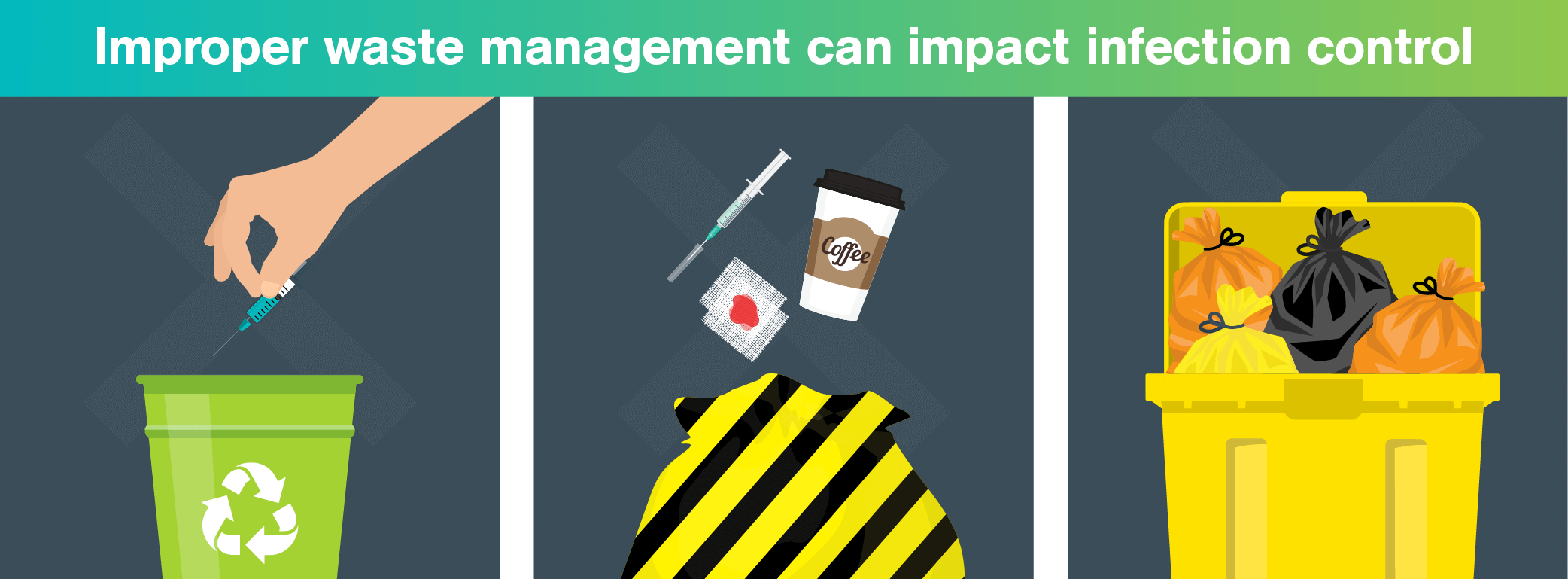
What do all infection control specialists have in common? They all aim to prevent the spread of infectious diseases and minimise the risks of cross-contamination or pathogen transmission in the healthcare setting. They’re also one of the most important facets of any facility. What does that have to do with waste? Waste management plays a significant and sometimes overlooked role in maintaining the safety and hygiene of a healthcare environment. Incorrect segregation, improper disposal and mismanagement pose a real risk to patients and staff.
In this blog, we’ll be taking a look at how healthcare waste management can impact infection control. We’ll also examine some industry best practices and learn about a waste management model that’s designed to reduce infection risk.
TOPICS WE WILL COVER:
1 / Understanding Healthcare Waste
2 / The Impact of Healthcare Waste Management on Infection Control
3 / Where Do Reusable Sharps Containers Come Into This?
4 / Best Practices within Healthcare Waste Management
5 / A Waste Management Model Built Around Infection Control
6 / Sharpsmart: Making Healthcare Safer for All
Understanding Healthcare Waste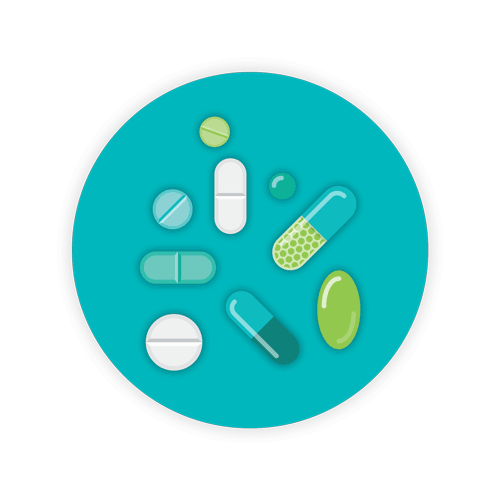
Healthcare waste is defined by the Environment Agency as—waste produced during human or animal healthcare, or related research activities. It covers both clinical and offensive waste. Clinical waste is any type of healthcare waste that has the potential to cause infection or disease.
Offensive waste is non-clinical recognisable waste that’s non-infectious; it cannot contain pharmaceutical or chemical substances but may be unpleasant to those who come into contact with it.
Other common healthcare and related waste streams include:
- Pharmaceutical waste (non-hazardous medicines)
- Sharps waste
- Anatomical waste
- Infectious waste for incineration
- Infectious waste suitable for alternative treatment
It’s highly recommended that healthcare providers have familiarity with the governmental regulations regarding their waste. The Waste Classification Technical Guidance is an important and helpful document regarding waste classification.
Proper classification and segregation of waste are crucial for minimising the risk of cross-contamination and the spread of infectious diseases. You may find our blog on using EWC codes to classify your waste helpful.
The Impact of Healthcare Waste Management on Infection Control
The mismanagement of waste can have serious consequences when it comes to infection transmission, one of the primary risks is the potential for cross-contamination. The potential spread of any infectious disease is a major concern and when waste isn’t properly segregated, there’s an increased risk of cross-contamination between different waste types leading to a higher risk of transmission. Also, when waste isn’t properly stored and disposed of, it can lead to unsanitary conditions in facilities; increasing the risk of patients and staff being exposed to infectious diseases.
Additionally, there are numerous negative environmental consequences of poor segregation practices and improper waste disposal. The release of hazardous materials, organisms, and pathogens into the environment can cause harm to people and wildlife, as well as impact the local ecosystem.
How It Affects Hospital Hygiene
Whilst the industry has come a long way in the 20+ years that we’ve been operating in the UK, there are some key areas that still have plenty of room for improvement, especially when it comes to hospital hygiene. Sharpsmart was founded on a vision that radically reimagined the standards of safety and hygiene in healthcare waste management; the sad part is that some of the challenges we identified over 20 years ago are still prevalent today.
Some of those include:
- Full-touch clinical waste containers; increasing the risk of the transmission of pathogens by hands.
- Poor segregation practices; leading to downstream staff being unknowingly exposed to high-risk wastes.
- A lack of safety-engineered devices for sharps disposal; exposing both staff and patients to risks of needlestick injuries.
- Open-top clinical waste bins beside patient beds; increasing the risk of cross-contamination from overhanging curtains.
- Unclean wall casings for disposable sharps containers; posing sharps injury and infection risks due to a build-up of mis-disposed sharps, dirt and grime.
- And unfortunately, that list goes on…
In a modern healthcare setting where the safety of patients and staff are a priority, none of the aforementioned challenges should be left unmet. Infection control is of the utmost importance and every microbial detail matters when considering how waste management affects hospital hygiene.
Where Do Reusable Sharps Containers Come Into This?
Reusable sharps containers are an effective asset for infection control and sharps waste management. ISO-compliant safety-engineered devices are used to store sharps waste safely and securely, minimising the risk of sharps injuries by restricting access to the enclosed waste.
The use of reusable sharps containers is a recommended best practice; they’re designed to be durable and secure, ensuring that sharps waste is safely stored and disposed of. In contrast, when sharps aren’t disposed of properly, they pose a significant risk of injury and infection from blood-borne pathogens.
Sharpsmart’s reusable containers are designed to prioritise safety; with features such as overfill protection and restricted hand access, they reduce the risk of injury and any associated infections for patients and staff.
Best Practices within Healthcare Waste Management
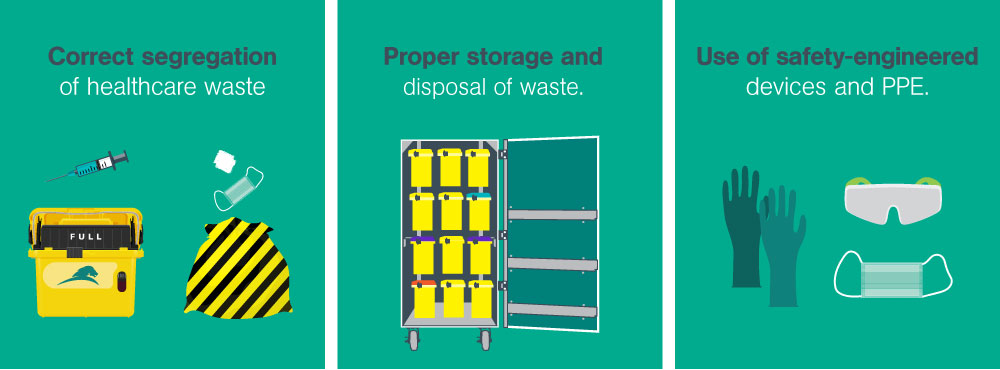
Three best practices that should be used at all times are:
- The correct segregation of healthcare waste.
- The proper storage and disposal of waste.
- The use of safety-engineered devices and PPE.
The correct segregation of healthcare waste is vital and enables the safe handling and disposal method to be used for each waste type and its appropriate waste stream.
The proper storage and disposal of waste directs that all wastes should be securely closed and labelled, stating their origin. When stored in a waste hold, containers must be provided for the different waste streams and both the waste hold and any containers used for hazardous waste should be lockable.
The use of safety-engineered devices and PPE is crucial for keeping staff and patients safe from the risk of infection.
A Waste Management Model Built Around Infection Control
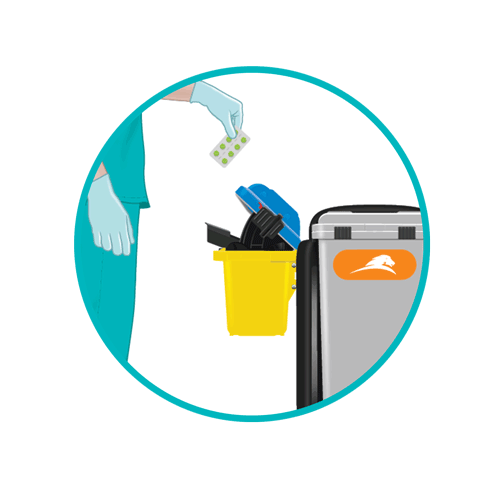
Sharpsmart provides much more than a collection service; we offer a waste management model built around infection control. We work with you and your teams within the four walls of your hospital to drive continued safety, efficiency optimisation and risk management; ensuring correct segregation and protecting your staff and patients. With a waste management model that prioritises safety and infection control, it’s no wonder we set the ISO standard for reusable sharps containers.
Here’s a handful of the relevant safety features of our containers:
- Proven to achieve 13x less microbial contamination than their counterparts.
- Designed with easy-to-clean high gloss non-porous surfaces.
- Supplied as a single sealed unit (no nesting), eliminating the moisture residue that enables microbial growth.
- Each unit goes through our robotic washing process, achieving a 10⁶ log bacterial kill in cleaning, decontamination, and sanitisation.
- Designed as single units, there’s no need for cabinets on walls; removing any residual containment to harbour dirt, dust, or pathogens.
- Designed to never touch the ground once filled. Our specialist carts, mounts and transporter units keep containers suspended to eliminate cross-contamination.
- Purpose-designed carts and floor stands enable hands-free disposal of waste without surface touch or manual handling.
How Does It Work?
Before any rollout, our consultants perform a full site-wide audit and review the layout of your facility to gain a thorough understanding of how waste is currently being managed; this enables us to develop a bespoke proposal optimised for the unique requirements of your site.
When installing Sharpsmart solutions, our expert technicians will ensure container position and mounting heights meet the safety needs of your facility. Education and training for staff are provided and any informational materials such as posters and labels are installed. Once implemented, the provided services are reviewed regularly to ensure you’re getting exactly what you need and achieving maximum results.
Sharpsmart: Making Healthcare Safer for All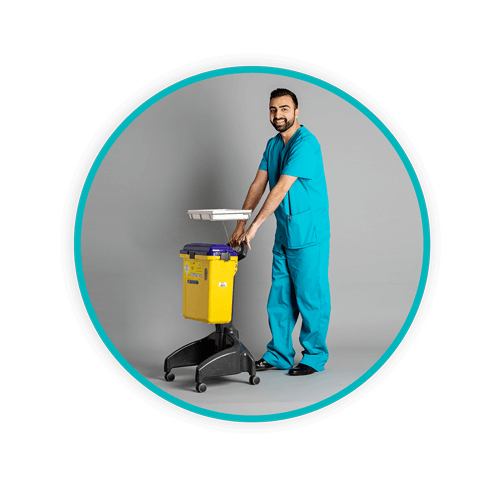
As we’ve seen, waste management is an essential component of infection control in any facility. The proper segregation, handling, storage, and disposal of waste minimises the risk of cross-contamination and the spread of infectious diseases.
Safety and care are essential for both patients and staff. To ensure the health and safety of everyone involved and maintain a clean environment, continued efforts towards proper waste management are vital; this includes ongoing education and training for staff, implementation of best practices and safety-engineered devices, and regular auditing and assessments.
We’re passionate and committed to making healthcare safer, join us in keeping your staff and patients protected by bringing an infection-control-based approach to your waste management.
Let's Talk!
Your time is valuable, and we don’t want to play hard to get. You can either phone us directly on the details listed on our contact page, or feel free to fill out this short form and one of our team members will get back to you as quickly as possible.
